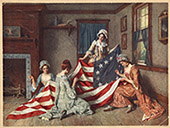Libraries, University of Nebraska-Lincoln
ORCID IDs
Document Type
Archival Material
Date of this Version
1638
Abstract
John Underhill’s Newes from America was the most complete contemporary published account of the Pequot War of 1636-1637. Underhill was one of the Massachusetts commanders in the expedition against Block Island in August 1636 and in the force that destroyed the fortified Pequot village at Mystic in May 1637.
The expansion of English settlements into the Connecticut River valley and the northern shore of Long Island Sound brought them into contact and conflict with new groups of Native inhabitants and into competition with the Dutch from New Netherlands. In July 1633, the trader John Oldham was killed off Block Island (probably by Narragansetts from the mainland), and early the following winter traders John Stone, Walter Norton, and six crew were killed by western Niantics, a tributary tribe of the Pequots. After a series of inconclusive negotiations, the Bay Colony sent a punitive expedition under John Endicott in August 1636 to reduce the Block Island Indians and to demand reparations from the mainland Pequots. This effort was only marginally successful: several villages, fields, and supply caches were destroyed, but the Indians avoided any pitched battles, although a number were killed. Having riled up the Natives of southern Connecticut, the army sailed back to the Bay. The Pequots retaliated on the Connecticut English by besieging their fort at Saybrook and attacking settlements along the Connecticut River through the winter and spring. The Connecticut and Bay colonies combined forces and engaged native Mohegan allies for a more definitive offensive. An army of about 100 militia under Underhill and John Mason left Saybrook by ship, landed on the western shore of the Narragansett Bay and enlisted the Narragansetts and Eastern Niantics as allies. They marched overland two days westward and surprised the Pequot fortified village near Mystic on May 26, 1637. The English attacked at dawn, and fired the village; the fleeing inhabitants were “received and entertained with the point of the sword.” Of the 600–800 village inhabitants, there were only 14 survivors. The next three months were spent searching and destroying or capturing the remaining members of the tribe. Most Pequot survivors were either sold in the West Indies or given to the Indian allies as slaves. As Underhill did not participate in these later campaigns, they receive short notice in his account.
John Underhill (c.1608–1672) was born in the Netherlands to English parents and received military training in the service of William, Prince of Orange. In 1630 he was hired by the Massachusetts Bay Colony with the rank of captain to help train the colony's militia. Following his service in the Pequot War, he faced charges of Antinomianism and adultery. He was removed from office and disenfranchised in 1637, banished in 1638, and excommunicated in 1640. He settled in Dover (New Hampshire) and ultimately was reconciled with the Massachusetts authorities after a public repentance. He removed to Connecticut in 1642, but left in 1653 to accept a captaincy in New Netherland’s military forces. He prosecuted their war with the Natives of Long Island and southwestern Connecticut, destroying villages at Massapequa and Stamford. He lived in Flushing until 1653, when he served with the English in their war with the Dutch. He afterwards returned to Long Island and settled at Oyster Bay, where he died in 1672.
As a writer, Underhill displays a disarmingly charming style, for someone who at least three times commanded the wholesale slaughter of Natives. His prose is studded with aphorisms (“More men would goe to Sea, if they were sure to meet with no stormes”) and wry commentary (on the Native style of battle: “after such a manner, as I dare boldly affirme, they might fight seven yeares and not kill seven men”). He interrupts his account of the landing at Block Island with a digression of the position of women in Massachusetts, and then resumes: “But to the matter, the Arrowes flying thicke about us, …” About a third of the Newes from America is devoted to the opportunities for settlement still remaining in Connecticut, Plymouth, Maine, or other places, mostly outside the jurisdiction of the Massachusetts Bay Colony. He writes also a long reflection, prompted by the story of the two “captive maids,” on the tribulations of the Christian and the necessity of “taking up the cross” and trusting in the Lord. He does also confront the question “Why should you be so furious (as some have said) should not Christians have more mercy and compassion?” and concludes: “We had sufficient light from the word of God for our proceedings.”
This online electronic edition of Newes from America is based on the text of the first edition published in London in 1638. The spelling, punctuation, etc., are those of the original edition. Some explanatory notes have been added at the end.


